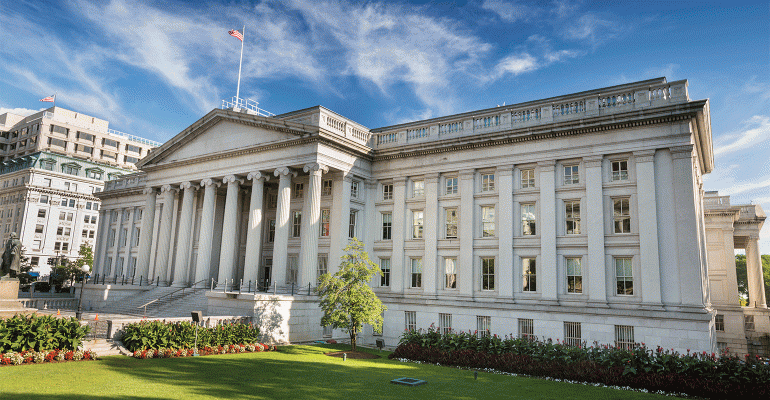The floodgates are scheduled to open on April 3 for restaurant operators to submit applications for forgivable federal loans under the newly created Paycheck Protection Program.
Part of the $2 trillion stimulus package signed by President Trump last week, the Paycheck Protection Program is a centerpiece of the Coronavirus Aid, Relief and Economic Security, or CARES, act designed to offer a lifeline to millions of small and mid-sized businesses to keep their workers employed.
Treasury Secretary Steven Mnuchin said in a statement, “Treasury and the Small Business Administration expect to have this program up and running by April 3rd so that businesses can go to a participating SBA 7(a) lender, bank or credit union, apply for a loan, and be approved on the same day. The loans will be forgiven as long as the funds are used to keep employees on the payroll and for certain other expenses.”
Though government loans are not traditionally known for speed, SBA Administrator Jovita Carranza pledged that the public-private partnership will allow businesses to access capital quickly.
“Our goal is to position lenders as the single point of contact for small businesses — the application, loan processing and disbursement of funds will all be administered at the community level,” he said in a statement. “Speed is the operative word; applications for the emergency capital can begin as early as this week, with lenders using their own systems and processes to make these loans. We remain committed to supporting our nation’s more than 30 million small businesses and their employees, so that they can continue to be the fuel for our nation’s economic engine.”
Sean Kennedy, executive vice president of the National Restaurant Association, said the loan application opening day is likely to be akin to buying tickets to a Rolling Stones concert.
“I have restaurant operators who have already said they literally will wait up until the clock strikes 12 to be in the queue,” he said.
The Paycheck Protection Program is designed for businesses with 500 or fewer workers. For restaurants and hotels specifically, however, the 500-employee count is based on the number of workers at each physical location.
So a restaurant franchisee or multiconcept group with 600 employees across five properties would qualify. So would large restaurant chains — so long as they have no physical locations with more than 500 workers.
Sean Kennedy, executive vice president of the National Restaurant Association, said, “The biggest win for the restaurant industry in this bill is the fact that we secured a carveout that maximizes the number of restaurants that can participate in this.”
In a letter to Mnuchin and Carranza on Wednesday, however, the NRA sought several clarifications, asking for clarity about whether a restaurant company can apply for a loan for each individual location. In other words, can the five-unit multiconcept group apply for one loan, or five?
“Ultimately for a lot of these restaurants, they are a small business, and by that I mean they are the community restaurant serving one area, and they were disproportionally hit by this,” said Kennedy. “We would like each location to be treated like an individual small business.”
The goal of the program is to provide eight weeks of payroll and certain overhead to keep workers employed, but the loans can be used to pay interest on mortgages, as well as rent and utilities.
The loan amount is based on 250% of the borrower’s average monthly payroll cost (average payroll costs x 2.5) for the preceding year, and provisions for seasonal employers are included, up to $10 million. For example, an employer with an average monthly payroll of $900,000 would be eligible for a loan of $2.25 million.
The loan is forgiven if at least 75% is used for payroll costs. Forgiveness is also based on employers maintaining or quickly rehiring workers and maintaining salary levels. If full-time headcounts or salaries/wages decline, so will forgiveness.
All loans under the program have an interest rate of 0.5% with a maturity of two years and first payment can be deferred for six months. Fees, collateral requirements and personal guarantees are waived.
These loans are fully guaranteed by the federal government through Dec. 31, 2020, and available through SBA-certified lenders. Applications will be accepted through June 30.
The NRA is also asking for a clearer description of the parameters for loan forgiveness.
Loan forgiveness is directly related to worker retention and rehiring, but the problem for restaurants is that they will not likely be able to immediate return to pre-coronavirus staffing levels, even with the injection of cash. The NRA has also asked for a formula that allows more time for employee onboarding as restaurants bring workers back.
In addition to the Paycheck Protection loans, the SBA is also offering Economic Injury Disaster Loans of up to $2 million to small businesses located in designated geographic areas. Disaster loans have a low-interest rate of 3.75% for those suffering economic injury as a result of coronavirus.
Businesses can also apply for an emergency advance of up to $10,000, which the SBA said does not have to be repaid.
Contact Lisa Jennings at [email protected]
Follow her on Twitter: @livetodineout





